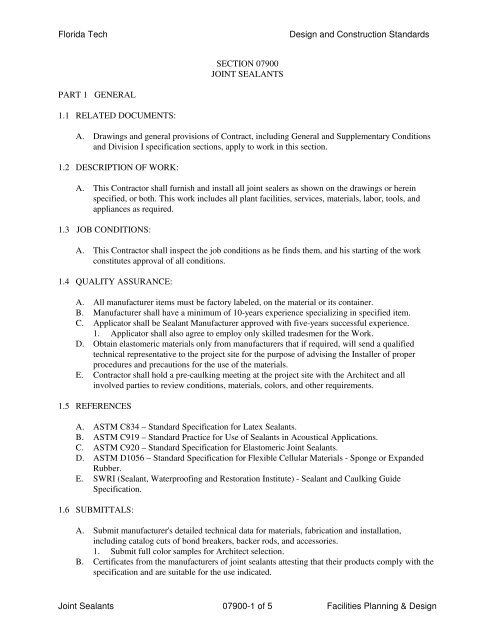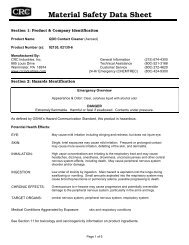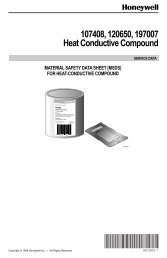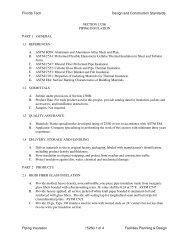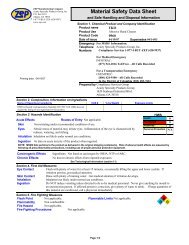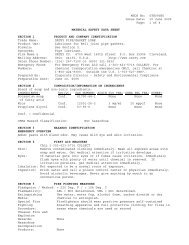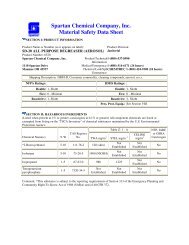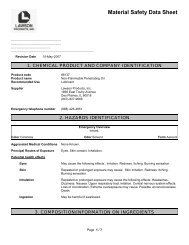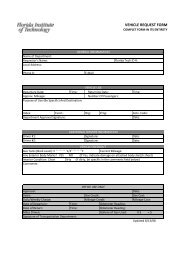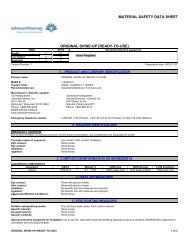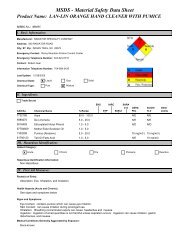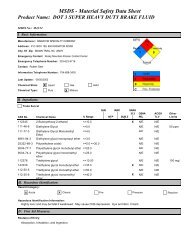Section 07900 Joint Sealants
Section 07900 Joint Sealants
Section 07900 Joint Sealants
Create successful ePaper yourself
Turn your PDF publications into a flip-book with our unique Google optimized e-Paper software.
Florida Tech<br />
Design and Construction Standards<br />
SECTION <strong>07900</strong><br />
JOINT SEALANTS<br />
PART 1 GENERAL<br />
1.1 RELATED DOCUMENTS:<br />
A. Drawings and general provisions of Contract, including General and Supplementary Conditions<br />
and Division I specification sections, apply to work in this section.<br />
1.2 DESCRIPTION OF WORK:<br />
A. This Contractor shall furnish and install all joint sealers as shown on the drawings or herein<br />
specified, or both. This work includes all plant facilities, services, materials, labor, tools, and<br />
appliances as required.<br />
1.3 JOB CONDITIONS:<br />
A. This Contractor shall inspect the job conditions as he finds them, and his starting of the work<br />
constitutes approval of all conditions.<br />
1.4 QUALITY ASSURANCE:<br />
A. All manufacturer items must be factory labeled, on the material or its container.<br />
B. Manufacturer shall have a minimum of 10-years experience specializing in specified item.<br />
C. Applicator shall be Sealant Manufacturer approved with five-years successful experience.<br />
1. Applicator shall also agree to employ only skilled tradesmen for the Work.<br />
D. Obtain elastomeric materials only from manufacturers that if required, will send a qualified<br />
technical representative to the project site for the purpose of advising the Installer of proper<br />
procedures and precautions for the use of the materials.<br />
E. Contractor shall hold a pre-caulking meeting at the project site with the Architect and all<br />
involved parties to review conditions, materials, colors, and other requirements.<br />
1.5 REFERENCES<br />
A. ASTM C834 – Standard Specification for Latex <strong>Sealants</strong>.<br />
B. ASTM C919 – Standard Practice for Use of <strong>Sealants</strong> in Acoustical Applications.<br />
C. ASTM C920 – Standard Specification for Elastomeric <strong>Joint</strong> <strong>Sealants</strong>.<br />
D. ASTM D1056 – Standard Specification for Flexible Cellular Materials - Sponge or Expanded<br />
Rubber.<br />
E. SWRI (Sealant, Waterproofing and Restoration Institute) - Sealant and Caulking Guide<br />
Specification.<br />
1.6 SUBMITTALS:<br />
A. Submit manufacturer's detailed technical data for materials, fabrication and installation,<br />
including catalog cuts of bond breakers, backer rods, and accessories.<br />
1. Submit full color samples for Architect selection.<br />
B. Certificates from the manufacturers of joint sealants attesting that their products comply with the<br />
specification and are suitable for the use indicated.<br />
<strong>Joint</strong> <strong>Sealants</strong> <strong>07900</strong>-1 of 5 Facilities Planning & Design
Florida Tech<br />
Design and Construction Standards<br />
1.7 DELIVERY, STORAGE, AND HANDLING<br />
A. Deliver materials to the project site in original unopened containers or bundles with labels<br />
indicating manufacturer, product name and designation, color, expiration period for use, pot life,<br />
curing time, and mixing instructions for multi-component materials.<br />
B. Store and handle materials in compliance with manufacturer’s requirements to prevent their<br />
deterioration or damage due to moisture, temperature, contaminants, or other causes.<br />
1.8 WARRANTY<br />
A. The Contractor shall furnish written guarantee that work executed under this section is free from<br />
defects of material and workmanship for a period of five-years from date of substantial<br />
completion of the entire project.<br />
1. Include coverage that he will, without delay and at his own expense repair and replace all<br />
such defects as may develop during the term of this guarantee.<br />
PART 2 PRODUCTS<br />
2.1 MANUFACTURERS<br />
A. Manufacturers: Subject to compliance with the requirements, provide products by one on the<br />
following:<br />
1. DAP, Inc., Dayton, Ohio<br />
2. Dow Corning Corp., Midland, Michigan<br />
3. General Electric Co., GE Silicones, Waterford, New York<br />
4. Mameco International, Inc., Cleveland, Ohio<br />
5. Pecora Corp., Harleysville, Pennsylvania<br />
6. Rhone-Poulenc, Inc., Plymount, New Jersey<br />
7. Sonneborn Building Products Div., Minneapolis, Minnesota<br />
8. Tremco, Inc., Beachwood, Ohio<br />
9. Hilti Construction Chemicals, Tulsa, Oklahoma<br />
B. Contractor may request other products or manufacturers for acceptance provided they equal or<br />
exceed the material requirements and functional qualities of the specified product.<br />
1. The "Substitution Request Form" and complete technical data for evaluation must<br />
accompany requests for Architect's approval.<br />
2. All materials for evaluation must be received at least 10-days prior to bid due date.<br />
3. Additional approved manufacturers will be issued by Addendum.<br />
2.2 MATERIALS<br />
A. General<br />
1. The term “Acceptable Standard” when used within this <strong>Section</strong>, refers to the manufacturer<br />
and product listed, specified as to type and quality required for this project.<br />
2. Single resource responsibility for joint sealer materials: Obtain joint sealer materials from a<br />
single manufacturer for each different product required.<br />
3. Compatibility: Provide joint sealers, joint fillers, and other related materials that are<br />
compatible with one another and with joint substrates under conditions of service and<br />
application, as demonstrated by sealant manufacturer based on testing and final experience.<br />
B. Caulking Compounds (Acrylic Latex Sealant)<br />
<strong>Joint</strong> <strong>Sealants</strong> <strong>07900</strong>-2 of 5 Facilities Planning & Design
Florida Tech<br />
Design and Construction Standards<br />
1. Latex rubber modified, acrylic emulsion polymer sealant compound; manufacturer’s<br />
standard, one part, non-sag, mildew resistant, acrylic emulsion sealant complying with<br />
ASTM C 834, formulated to be painted and recommended for exposed applications on<br />
interior locations involving joint movement of not more than plus or minus 5%.<br />
2. Acceptable Standard<br />
a. “Sonolac”; Sonneborn Building Products, Inc.<br />
b. “Acrylic Latex Caulk 832”; Tremco, Inc.<br />
c. “Acrylic Latex Caulk with Silicone”; DAP<br />
d. “AC-20”; Pecora Corp.<br />
C. One-Part Elastomeric Sealant (Silicone)<br />
1. One component elastomeric sealant complying with ASTM C 920, Class 25, Type NS (nonsag),<br />
unless manufacturer recommends Type S (self-leveling) for the application shown.<br />
a. Acceptable Standard<br />
i) “Pecora 864 Architectural Silicone Sealant; Pecora Corp.<br />
ii) “Dow Corning 791; Dow Corning Corp.<br />
iii) “Silpruf”: General Electric<br />
iv) “Omniseal”; Sonneborn Building Products, Inc.<br />
v) “Spectrem 2; Tremco Mtg. Co.<br />
2. One component mildew resistant silicone sealant (around countertops and backsplashes and<br />
other wet interior locations.)<br />
a. Acceptable Standard<br />
i) “Rhodorsil 6B White”; Rhone-Poulenc, Inc.<br />
ii) “Dow Corning 786”, Dow Corning Corp.<br />
iii) “Sanitary 1700”; General Electric<br />
3. One-component high movement joints (+100/-50): Where locations of high movement are<br />
indicated.<br />
a. “Dow Corning 790”; Dow Corning Corp.<br />
b. “Spectrem 1”; Tremco<br />
D. Elastomeric Sealant (Polyurethane)<br />
1. One component polyurethane sealant, complying with ASTM C 920, Type S, Grade NS,<br />
Class 25 (non-sag).<br />
a. Acceptable Standard<br />
i) “Sonolastic NP 2”; Sonneborn Building Products, Inc.<br />
ii) “Dymonic”: Tremco Mfg. Co.<br />
iii) “Dynatrol I”; Pecora Corp.<br />
iv) “Vulkem 921”; Mameco<br />
v) “CS 2130”; Hilti<br />
2. Two component polyurethane sealant, complying with ASTM C920, Type M, Grade NS,<br />
Class 25 (non-sag).<br />
a. Acceptable Standard<br />
i) “Sonolastic NP 2” Sonneborn Building Products, Inc.<br />
ii) “Dymeric 511”; Tremco Mfg. Co.<br />
iii) “Dynatrol II”; Pecora Corp.<br />
iv) “Vulkem 922”; Mameco<br />
E. One-part self-leveling polyurethane sealant (for traffic areas)<br />
1. One component polyurethane self-leveling sealant, complying with ASTM C 920, Type S,<br />
Grade P, Class 25.<br />
a. Acceptable Standard<br />
i) “Sonolastic SL 1”; Sonneborn Building Products, Inc.<br />
ii) “NR-201 Urexpan”; Pecora Corp.<br />
<strong>Joint</strong> <strong>Sealants</strong> <strong>07900</strong>-3 of 5 Facilities Planning & Design
Florida Tech<br />
Design and Construction Standards<br />
iii) “Vulkem 45”; Mameco<br />
2. Two component polyurethane self-leveling sealant, complying with ASTM C920, Type M,<br />
Grade P, Class 25.<br />
a. Acceptable Standard<br />
i) “Sonolaastic SL 2”; Sonneborn Building Products, Inc.<br />
ii) “NR-200 Urexpan”: Pecora Corp.<br />
iii) “Vulkem 245”; Mameco<br />
iv) “THC900/THC901”: Tremco<br />
F. Security Sealant (Polyurethane)<br />
1. One component or two component polyurethane sealant, complying with ASTM C 920,<br />
Grade NS, Class 12.5 with a Shore A Hardness of 55.<br />
a. Acceptable Standard<br />
i) “Dynaflex”, Pecora Corp.<br />
ii) “Ultra”, Sonneborn Building Products, Inc.<br />
G. Miscellaneous Materials<br />
1. Provide joint cleaner and joint primer sealer as recommended by the sealant or caulking<br />
compound manufacturer.<br />
2. Sealant backer rod shall be compressible rod stock, polyethylene foam, polyethylene<br />
jacketed polyurethane foam, butyl rubber foam, neoprene foam, or other materials as<br />
recommended by sealant manufacturer.<br />
a. Where a 2" building expansion joint is indicated, provide a expanding foam secondary<br />
sealant, “BackerSeal” as manufactured by Emseal <strong>Joint</strong> Systems, Ltd., Westborough,<br />
MA or Apolytite Standard @ as manufactured by Polytite Manufacturing Corporation,<br />
Cambridge, MA, behind sealant in lieu of standard backer rod.<br />
3. Primer: Provide type recommended by joint sealer manufacturer where required for<br />
adhesion of sealant to joint substrates indicated, as determined from preconstruction joint<br />
sealer substrate tests and field tests.<br />
4. Cleaners for Nonporous Surfaces: Provide non-staining, chemical cleaners of type which<br />
are acceptable to manufacturers of sealants and sealant backing materials, which are not<br />
harmful to substrates and adjacent nonporous materials, and which do not leave oily<br />
residues or otherwise have a detrimental effect on sealant adhesion or in service<br />
performance.<br />
5. Masking Tape: Provide non-staining, non-absorbent type compatible with joint sealants and<br />
to surfaces adjacent to joints.<br />
PART 3 EXECUTIONS<br />
3.1 INSPECTION:<br />
A. This Contractor shall notify the General Contractor, when he has completed his work and is<br />
ready for A/E inspection.<br />
B. Verify that substrate surfaces and joint openings are ready to receive work.<br />
C. Verify that joint backing and release tapes are compatible with sealant.<br />
D. Clean and prime joints in accordance with manufacturer’s instructions.<br />
E. Remove loose materials and foreign matter that might impair adhesion of sealant.<br />
3.2 INSTALLATION:<br />
A. All products shall be installed in strict accordance to all manufacturer's recommendations.<br />
B. Measure joint dimensions and size materials to achieve required width/depth ratios.<br />
<strong>Joint</strong> <strong>Sealants</strong> <strong>07900</strong>-4 of 5 Facilities Planning & Design
Florida Tech<br />
Design and Construction Standards<br />
C. Install joint backing to achieve a neck dimension no greater than 1/3 the joint width.<br />
D. Install bond breaker where joint backing is not used.<br />
E. Install sealant free of air pockets, foreign embedded matter, ridges, and sags.<br />
F. Apply sealant within recommended application temperature ranges. Consult manufacturer when<br />
sealant cannot be applied within these temperature ranges.<br />
G. Tool joints concave.<br />
3.3 ADJUSTMENT AND CLEANING:<br />
A. After installation, all exposed surfaces shall be thoroughly cleaned, and all damaged material<br />
shall be restored to its original condition, or replaced with new material.<br />
END OF SECTION<br />
<strong>Joint</strong> <strong>Sealants</strong> <strong>07900</strong>-5 of 5 Facilities Planning & Design


